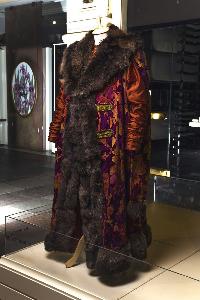Joseph Spinel
Joseph Spinel;Iosif Shpinel
Place: Bila Tserkva
Born: 1892
Death: 1980
Biography:
Iossif Aronovich Shpinel (September 25, 1892 – July 2, 1980) was a Russian painter, graphic artist and scenic designer of more than 60 films including Ivan the Terrible and Alexander Nevsky by Sergei Eisenstein. Born as the eighth child in the poor Jewish family of a teacher in Belaya Tserkov (Ukrainian: Bila Tserkva, Ukraine), he survived several pogroms. First in Kiev, then in Moscow, he studied architecture. Then he continued his education in Vkhutemas (Higher Art and Technical Studios) with the great master of graphic design Vladimir Favorsky. As a graphic artist he had illustrated several books in the 1920s, where modernist graphic design was used: To illustrate Gastev’s ideas, Iosif Shpinel’ created a series of sketches in the suprematist and constructivist styles that accentuated this approach to the “education of the body as a working machine”. Shpinel’s artistic education took place in one of the prominent centres of Soviet avant-garde art and architecture: from 1921 to 1926, he studied in the architecture department of the Higher Art and Technical Workshops in Moscow (VKhUTEMAS). Later he worked as a set designer with such prominent film directors as Aleksandr Dovzhenko (The Arsenal, 1929, and Ivan, 1932), Mikhail Romm (Boule de Suif, 1934), and Sergei Eisenstein (Alexander Nevskyi, 1938, and Ivan the Terrible, 1944–6). His illustrations for Youth, Go! convey an image of the body reduced to a number of basic geometric shapes – circles, triangles, rectangles; a body devoid of symmetry and naturalness, and instead resembling a mannequin with limbs suspended on spherical joints and body parts freely detachable one from another. ... In Youth, Go!, the anatomy of the human hand is followed by the anatomy of an axe, insofar as both are part of a single whole: the new socialist working class. As a major film artist and architect, he was renowned for his ingenuity: A copy of the cathedral in Novgorod was built in the workshop of film architect Josef Spinel. The winter landscape with snow was captured on a few warm days in June, and the vast area was covered in chalk. He has taught since 1928, since 1940 at the Art Faculty of the All-Union State Institute of Cinematography VGIK, where he became a professor in 1965. His students became leading set designers at Soviet film studies.

